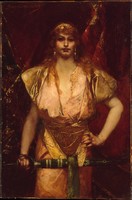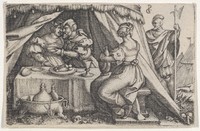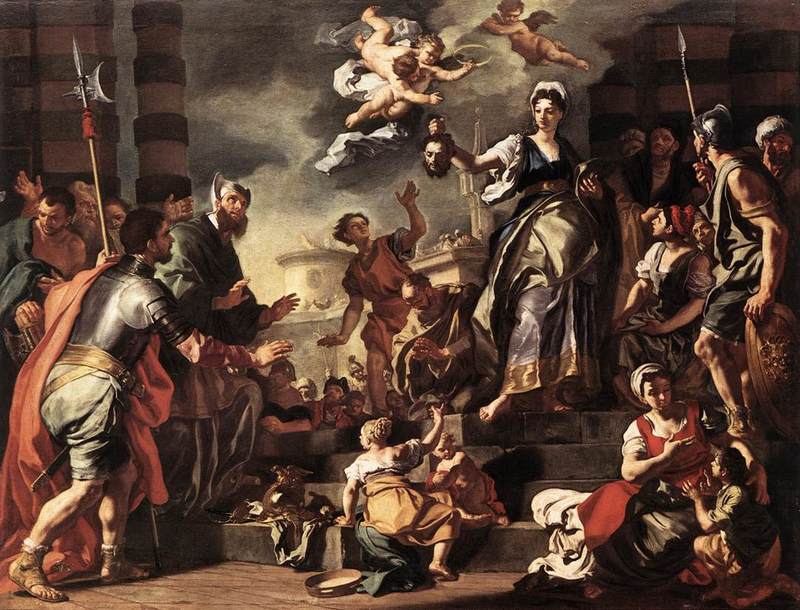The Story of Judith and Holofernes
The biblical story of Judith and Holofernes originates from the Book of Judith in the Old Testament—a book excluded from Hebrew and Protestant texts but considered part of the Roman Catholic biblical canon. It is a story of a Jewish woman's defeat over an army intended on world domination but, ultimately, a story of heroism over one's oppressors, female rage, and bodily autonomy.
Our story begins with the town of Bethulia, which lies just before the city of Jerusalem. The town has been under siege by the Assyrian army sent by king Nebuchadnezzar for 34 days, the townspeople having grown restless and thirsty from their water supply having been shut off. The leaders and magistrates of the town eventually succumb to the urgency of the townspeople, expressing their plan to surrender to the Assyrians in five days (lest the Lord takes pity on them). Judith, a beautiful widow born of Bethulia, overhears these plans of surrender, and concocts a plan of her own. She summons the leaders and magistrates into her home, declaring her plan to "deliver the city" from the clutches of the Assyrians, neglecting to disclose anything further. They listen without interruption and, like all the men in this tale, do as she says, opening the gates of the city so that she and her maidservant may be let out.
Judith and her maidservant leave the city with the intention of being captured by the Assyrians as a way to get to the head of the operation, the war general Holofernes. Her way of dress is calculated—throughout the book, she is described as having men at her beck and call due to her unwavering beauty, and dresses to enhance her assets and "entice the eyes of all men who might see her" (Judith 10:4). She and her maidservant are stopped and captured by Assyrian soldiers, who lead her directly to Holofernes. Judith fabricates a story of how she fled from the city because of the inevitability of its demise by his hand, and he is taken by her beauty and eloquence, welcoming her into the camp without question. In order to further appeal to her target, once given the opportunity she rids herself of her widow's rags, bathing herself in perfumes and donning jewels and luxurious fabrics. Whilst dining with Holofernes in his tent, Judith reclines, effortless in her beauty, as she flatters the general. Holofernes drinks himself unconscious over the prospect of bedding the beautiful woman before him. Judith beheads him as he sleeps with two swift sweeps from his own sword, promptly placing his severed head into the sack offered to her by her maidservant.
They return to Bethulia after alluding the soldiers once more, Judith shouting at the gates upon her arrival. She brandishes the severed head of the man responsible for their torment, retelling the tale of him meeting his demise due to her beauty, and thus immortalizing herself in history as the heroine who saved Jerusalem.
Just as Judith, her defeat over the Assyrian general Holofernes quickly became immortalized within the art historical canon. Her story and she herself became an icon of womanly virtue and piety, of female rage. Judith and the Head of Holofernes is a deep-dive into the various interpretations of Judith beheading Holofernes, attempting to make reason of the relevance and popularity of the subject in art history, paying close attention to repetition of visual allegory/motif.
The pieces in the exhibit will be displayed in sequential order, ranging all the way from the late 15th to early 20th century. Each piece will be analyzed visually, a detailed description of the intepretation, how the artist has interpreted the characters of our story, and brief insight into the artist's background. The exhibit will conclude with a cross examination of all the pieces, highlighting overarching themes, details which distinguish the piece from others, etc. These findings will be used in a final analysis of the story done through a feminist lense, drawing in specific details from the pieces.
When going through the exhibit, I ask that you interpret the pieces as you wish, of course, but also look for details that may lead someone to interpreting it as having protofeminist undertones. Thank you, and enjoy as these artists bring to life the iconic story of Judith and Holofernes.
-Abigail Paternina
1. Robin Branch, “Judith: A Remarkable Heroine,” Biblical Archaeology Society, January 31, 2020, https://www.biblicalarchaeology.org/daily/people-cultures-in-the-bible/people-in-the-bible/judith-a-remarkable-heroine/.
2. “Judith,” Metmuseum.org (The Metropolitan Museum of Art, 2020), https://www.metmuseum.org/art/collection/search/432101?searchField=All&.
3. “Judith and Holofernes Dining,” Metmuseum.org (The Metropolitan Museum of Art, 2020), https://www.metmuseum.org/art/collection/search/432101?searchField=All&.
4. Emily Kren and Daniel Marx, “Judith with the Head of Holofernes by SOLIMENA, Francesco,” www.wga.hu (Web Gallery of Art), accessed March 27, 2020, https://www.wga.hu/html_m/s/solimena/1/judith_p.html.


